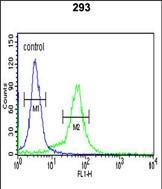BTBD1 Antibody (Center)
Purified Rabbit Polyclonal Antibody (Pab)
- 产品详情
- 实验流程
- 背景知识
Application
| WB, FC, E |
|---|---|
| Primary Accession | Q9H0C5 |
| Other Accession | P58544 |
| Reactivity | Human, Mouse |
| Host | Rabbit |
| Clonality | Polyclonal |
| Isotype | Rabbit IgG |
| Calculated MW | 52771 Da |
| Antigen Region | 295-322 aa |
| Gene ID | 53339 |
|---|---|
| Other Names | BTB/POZ domain-containing protein 1, Hepatitis C virus NS5A-transactivated protein 8, HCV NS5A-transactivated protein 8, BTBD1, C15orf1, NS5ATP8 |
| Target/Specificity | This BTBD1 antibody is generated from rabbits immunized with a KLH conjugated synthetic peptide between 295-322 amino acids from the Central region of human BTBD1. |
| Dilution | WB~~1:1000 FC~~1:10~50 E~~Use at an assay dependent concentration. |
| Format | Purified polyclonal antibody supplied in PBS with 0.09% (W/V) sodium azide. This antibody is prepared by Saturated Ammonium Sulfate (SAS) precipitation followed by dialysis against PBS. |
| Storage | Maintain refrigerated at 2-8°C for up to 2 weeks. For long term storage store at -20°C in small aliquots to prevent freeze-thaw cycles. |
| Precautions | BTBD1 Antibody (Center) is for research use only and not for use in diagnostic or therapeutic procedures. |
| Name | BTBD1 |
|---|---|
| Synonyms | C15orf1, NS5ATP8 |
| Function | Probable substrate-specific adapter of an E3 ubiquitin- protein ligase complex which mediates the ubiquitination and subsequent proteasomal degradation of target proteins (PubMed:14528312). Seems to regulate expression levels and/or subnuclear distribution of TOP1, via an unknown mechanism (By similarity). May play a role in mesenchymal differentiation where it promotes myogenic differentiation and suppresses adipogenesis (By similarity). |
| Cellular Location | Cytoplasm. Note=Localizes to punctate or elongated cytoplasmic bodies. |
| Tissue Location | Ubiquitous; highest levels in testes, heart and skeletal muscle. |
For Research Use Only. Not For Use In Diagnostic Procedures.
Provided below are standard protocols that you may find useful for product applications.
BACKGROUND
BTBD1 binds topoisomerase I. The N-terminus contains a proline-rich region and a BTB/POZ domain (broad-complex, Tramtrack and bric a brac/Pox virus and Zinc finger), both of which are typically involved in protein-protein interactions. Subcellularly, the protein localizes to cytoplasmic bodies.
REFERENCES
Pisani,D.F., Cabane,C. Cell Death Differ. 11 (11), 1157-1165 (2004)
Xu,L., Yang,L. Exp. Cell Res. 288 (1), 84-93 (2003)
Xu,L., Yang,L. BMC Genomics 3 (1), 1 (2002)
终于等到您。ABCEPTA(百远生物)抗体产品。
点击下方“我要评价 ”按钮提交您的反馈信息,您的反馈和评价是我们最宝贵的财富之一,
我们将在1-3个工作日内处理您的反馈信息。
如有疑问,联系:0512-88856768 tech-china@abcepta.com.























 癌症的基本特征包括细胞增殖、血管生成、迁移、凋亡逃避机制和细胞永生等。找到癌症发生过程中这些通路的关键标记物和对应的抗体用于检测至关重要。
癌症的基本特征包括细胞增殖、血管生成、迁移、凋亡逃避机制和细胞永生等。找到癌症发生过程中这些通路的关键标记物和对应的抗体用于检测至关重要。 为您推荐一个泛素化位点预测神器——泛素化分析工具,可以为您的蛋白的泛素化位点作出预测和评分。
为您推荐一个泛素化位点预测神器——泛素化分析工具,可以为您的蛋白的泛素化位点作出预测和评分。 细胞自噬受体图形绘图工具为你的蛋白的细胞受体结合位点作出预测和评分,识别结合到自噬通路中的蛋白是非常重要的,便于让我们理解自噬在正常生理、病理过程中的作用,如发育、细胞分化、神经退化性疾病、压力条件下、感染和癌症。
细胞自噬受体图形绘图工具为你的蛋白的细胞受体结合位点作出预测和评分,识别结合到自噬通路中的蛋白是非常重要的,便于让我们理解自噬在正常生理、病理过程中的作用,如发育、细胞分化、神经退化性疾病、压力条件下、感染和癌症。








